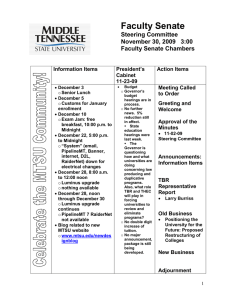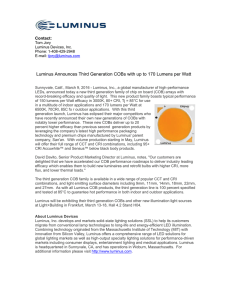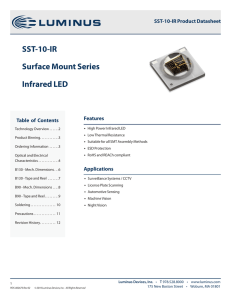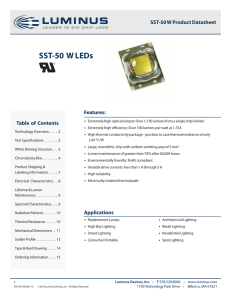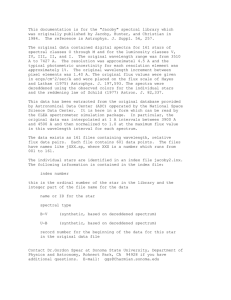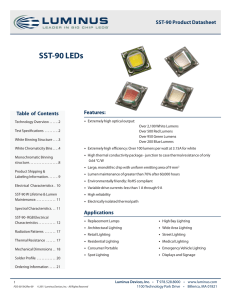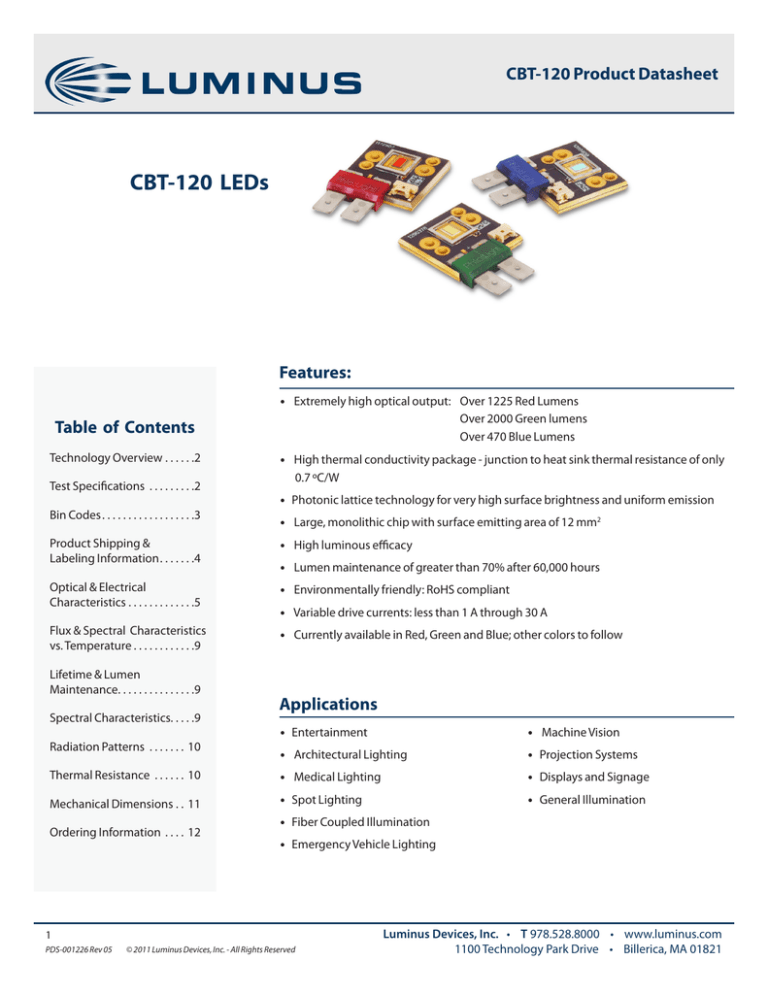
CBT-120
CBT-120Product
Product Datasheet
CBT-120 LEDs
Features:
Table of Contents
Technology Overview. . . . . . 2
Test Specifications . . . . . . . . . 2
Bin Codes. . . . . . . . . . . . . . . . . . 3
• Extremely high optical output: Over 1225 Red Lumens
Over 2000 Green lumens
Over 470 Blue Lumens
• High thermal conductivity package - junction to heat sink thermal resistance of only
0.7 ºC/W
• Photonic lattice technology for very high surface brightness and uniform emission
• Large, monolithic chip with surface emitting area of 12 mm2
Product Shipping &
Labeling Information. . . . . . . 4
• High luminous efficacy
Optical & Electrical
Characteristics. . . . . . . . . . . . . 5
• Environmentally friendly: RoHS compliant
Flux & Spectral Characteristics
vs. Temperature. . . . . . . . . . . . 9
• Currently available in Red, Green and Blue; other colors to follow
Lifetime & Lumen
Maintenance. . . . . . . . . . . . . . . 9
Spectral Characteristics. . . . .9
• Lumen maintenance of greater than 70% after 60,000 hours
• Variable drive currents: less than 1 A through 30 A
Applications
• Entertainment
• Machine Vision
• Architectural Lighting
• Projection Systems
Thermal Resistance . . . . . . . 10
• Medical Lighting
• Displays and Signage
Mechanical Dimensions. . . 11
• Spot Lighting
• General Illumination
Radiation Patterns . . . . . . . . 10
Ordering Information . . . . . 12
• Fiber Coupled Illumination
• Emergency Vehicle Lighting
1
PDS-001226 Rev 05
© 2011 Luminus Devices, Inc. - All Rights Reserved
Luminus Devices, Inc. • T 978.528.8000 • www.luminus.com
1100 Technology Park Drive • Billerica, MA 01821
CBT-120 Product Datasheet
Technology Overview
Luminus Big Chip LEDs™ benefit from a suite of innovations in the fields of chip technology, packaging and thermal management. These
breakthroughs allow illumination engineers and designers to achieve solutions that are high brightness and high efficiency.
Photonic Lattice Technology
Luminus’ photonic lattice technology enables large area LED
chips with uniform brightness over the entire LED chip surface.
The optical power and brightness produced by these large
monolithic chips enable solutions which replace arc and
halogen lamps where arrays of traditional high power LEDs
cannot.
For red, green and blue LEDs, the photonic lattice structures
extract more light and create radiation patterns that are more
collimated than traditional LEDs. Having higher collimation
from the source increases optical collection efficiencies and
simplifies optical designs.
Reliability
Designed from the ground up, Luminus Big Chip LEDs are one of
the most reliable light sources in the world today. Big Chip LEDs
have passed a rigorous suite of environmental and mechanical
stress tests, including mechanical shock, vibration, temperature
cycling and humidity, and have been fully qualified for use in
extreme high power and high current applications. With very
low failure rates and median lifetimes that typically exceed
60,000 hours, Luminus Big Chip LEDs are ready for even the
most demanding applications.
Environmental Benefits
Packaging Technology
Thermal management is critical in high power LED applications.
With a thermal resistance from junction to heat sink of 0.7º C/W,
Luminus CBT-120 LEDs have the lowest thermal resistance of
any LED on the market. This allows the LED to be driven at
higher current densities while maintaining a low junction
temperature, thereby resulting in brighter solutions and longer
lifetimes.
Luminus LEDs help reduce power consumption and the amount
of hazardous waste entering the environment. All Big Chip LED
products manufactured by Luminus are RoHS compliant and
free of hazardous materials, including lead and mercury.
Understanding Big Chip LED Test Specifications
Every Luminus LED is fully tested to ensure that it meets the high quality standards expected from Luminus’ products.
Testing Temperature
Multiple Operating Points (4.2 A, 18 A, 30 A)
Luminus core board products are typically measured in such a
way that the characteristics reported agree with how the
devices will actually perform when incorporated into a system.
This measurement is accomplished by mounting the devices on
a 40ºC heat sink and allowing the device to reach thermal
equilibrium while fully powered. Only after the device reaches
equilibrium are the measurements taken. This method of
measurement ensures that Luminus Big Chip LEDs perform in
the field just as they are specified.
The tables on the following pages provide typical optical and
electrical characteristics. Since the LEDs can be operated over a
wide range of drive conditions(currents from <1A to 30 A, and
duty cycle from <1% to 100%), multiple drive conditions
are listed.
2
PDS-001226 Rev 05
© 2011 Luminus Devices, Inc. - All Rights Reserved
CBT-120 devices are production specified at 18 A. The values
shown at 4.2 A and 30 A are for additional reference at other
possible drive conditions.
Luminus Devices, Inc. • T 978.528.8000 • www.luminus.com
1100 Technology Park Drive • Billerica, MA 01821
CBT-120 Product Datasheet
Big Chip CBT-120 RGB Bin Structure
CBT-120 LEDs are specified for luminous flux and chromaticity/wavelength at a drive current of18 A (1.5 A/mm2) and placed into one of
the following luminous flux (FF) and wavelength (WW) bins:
Blue Bins
Luminous Flux (lumens)
DN
DM
DK
DJ
DH
DG
700
CP
575
CN
Luminous Flux (lumens)
DP
Green Bins
450
350
250
200
150
CM
2300
CK
2000
CJ
1500
CH
1200
CG
1000
G7
G8
545
G6
540
G5
535
G4
530
G3
525
G2
Wavelength (nm)
520
B9
515
B8
510
B7
2600
475
B6
470
465
B5
460
455
450
B4
2900
G9
Wavelength (nm)
Red Bins
BP
Luminous Flux (lumens)
BN
BM
BK
BJ
BH
BG
1350
1150
970
770
600
475
350
R6
R7
635
R5
631
R4
627
R3
623
619
615
611
R2
R8
Wavelength (nm)
Note 1: Luminus maintains a +/- 6% tolerance on flux measurements.
Note 2: Only specific bins are available, please call Luminus sales team for details.
3
PDS-001226 Rev 05
© 2011 Luminus Devices, Inc. - All Rights Reserved
Luminus Devices, Inc. • T 978.528.8000 • www.luminus.com
1100 Technology Park Drive • Billerica, MA 01821
CBT-120 Product Datasheet
CBT-120 Shipping & Labeling Information
All CBT-120 products are packaged and labeled with their respective bin as outlined in the tables on page 3. When shipped, each
package will only contain one bin. The part number designation is as follows:
CBT 120
X C11
FF
WW
Product Family
Chip Area
Color
Package Configuration
Flux Bin
Wavelength Bin
CBT: Chip on Board
120: 12.0 mm2
R: Red
G: Green
B: Blue
C11: 28 x 27 mm board
See page 3 for bins
See page 3 for bins
Note 1: WNNX nomenclature corresponds to the following:
W = White
NN = color temperature, where:
65 corresponds to 6500K
40 corresponds to 4000K
30 corresponds to 3000K, etc.
X = color rendering index, where:
S (standard) corresponds to a typical CRI of 70
M (moderate) corresponds to a typical CRI of 83
H (high) corresponds to a typical CRI of 92
Note 2: Some flux and wavelength bins may have limited availability. Application specific bin kits, consisting of multiple bins, may be available. For
ordering information, please refer to page 12 and reference the PDS-001393 Binning and Labeling Rev 06 document.
Example:
The part number CBT-120-R-C11-BM-R4 refers to a red, CBT-120 module, with a flux range of 970-1,150 lumens and a wavelength range of 619 nm to
623 nm.
4
PDS-001226 Rev 05
© 2011 Luminus Devices, Inc. - All Rights Reserved
Luminus Devices, Inc. • T 978.528.8000 • www.luminus.com
1100 Technology Park Drive • Billerica, MA 01821
CBT-120 Product Datasheet
Reference Optical & Electrical Characteristics
(Theat sink = 40ºC)0
Red
4.2 A
Continuous
Drive Condition2
Parameter
Symbol
Current Density
0.35
Unit
1.5
VF min
2.5
A/mm2
2.0
Vf
1.8
V
2.3
VF max
Luminous Flux
30 A
Pulsed 50% D.F.3
Values4
j
Forward Voltage
18 A
Continous
2.6
V
2.6
V
ΦV typ
190
825
1400
lm
ΦR
1.3
5.5
8.0
W
η
26
20
18
lm/W
Dominant Wavelength
λd
622
623
623
nm
Peak Wavelength
λp
625
628
629
nm
5
Radiometric Flux
Luminous Efficacy
6
Color Saturation
FWHM
-
1.00
1.00
1.00
-
Δλ1/2
16
19
20
nm
x
0.695
0.699
0.702
-
y
0.305
0.301
0.298
-
Chromaticity
Coordinates7,8
Relative Output Flux vs. Forward Current1
Forward Current vs. Forward Voltage
35
1800
CW
Pulsed
1600
1400
30
25
IF (A)
1000
v
(lm)
1200
800
600
20
15
10
400
5
200
0
0
0
5
10
15
20
IF (A)
25
30
35
0
0.5
1
1.5
2
2.5
3
VF (V)
Yellow squares indicate reference drive conditions
Notes: See page 8
5
PDS-001226 Rev 05
© 2011 Luminus Devices, Inc. - All Rights Reserved
Luminus Devices, Inc. • T 978.528.8000 • www.luminus.com
1100 Technology Park Drive • Billerica, MA 01821
CBT-120 Product Datasheet
Reference Optical & Electrical Characteristics
(Theat sink = 40ºC)1
Green
4.2 A
Continuous
Drive Condition2
Parameter
Symbol
Current Density
0.35
Unit
1.5
VF min
2.5
A/mm2
3.8
Vf
3.5
V
4.3
VF max
Luminous Flux
30 A
Pulsed 50% D.F.3
Values4
j
Forward Voltage
18 A
Continous
4.9
V
4.9
V
ΦV typ
800
2100
3100
lm
ΦR
1.6
4.1
6.3
W
η
55
28
21
lm/W
Dominant Wavelength
λd
535
528
521
nm
Peak Wavelength
λp
530
524
521
nm
5
Radiometric Flux
Luminous Efficacy
6
Color Saturation
FWHM
Chromaticity
Coordinates7,8
-
0.91
0.83
0.79
-
Δλ1/2
35
39
40
nm
x
0.205
0.175
0.161
-
y
0.740
0.730
0.722
-
Relative Output Flux vs. Forward Current1
3500
35
CW
Pulsed
3000
30
2500
25
2000
20
IF (A)
(lm)
Forward Current vs. Forward Voltage
v
1500
15
1000
10
500
5
0
0
0
5
10
15
20
IF (A)
25
30
35
0
1
2
3
4
5
6
VF (V)
Yellow squares indicate reference drive conditions
Notes: See page 8
6
PDS-001226 Rev 05
© 2011 Luminus Devices, Inc. - All Rights Reserved
Luminus Devices, Inc. • T 978.528.8000 • www.luminus.com
1100 Technology Park Drive • Billerica, MA 01821
CBT-120 Product Datasheet
Reference Optical & Electrical Characteristics
(Theat sink = 40ºC)1
Blue
4.2 A
Continuous
Drive Condition2
Parameter
18 A
Continous
Symbol
Current Density
Values4
j
0.35
2.5
A/mm2
3.5
Vf
3.4
V
4.1
VF max
Luminous Flux
Unit
1.5
VF min
Forward Voltage
30 A
Pulsed 50% D.F.3
4.5
V
5.0
V
ΦV typ
150
400
600
lm
ΦR
2.7
7.2
12.3
W
η
11
6
5
lm/W
Dominant Wavelength
λd
462
462
462
nm
Peak Wavelength
λp
459
460
460
nm
5
Radiometric Flux
Luminous Efficacy
6
Color Saturation
FWHM
Chromaticity
Coordinates7,8
-
0.99
0.99
0.99
-
Δλ1/2
22
25
27
nm
x
0.142
0.142
0.142
-
y
0.036
0.038
0.038
-
Relative Output Flux vs. Forward Current1
800
700
Forward Current vs. Forward Voltage
CW
35
Pulsed
30
25
500
IF (A)
20
400
15
v
(lm)
600
300
10
200
5
100
0
0
0
5
10
15
20
IF (A)
25
30
35
0
1
2
3
4
5
VF (V)
Yellow squares indicate reference drive conditions
Notes: See page 8
7
PDS-001226 Rev 05
© 2011 Luminus Devices, Inc. - All Rights Reserved
Luminus Devices, Inc. • T 978.528.8000 • www.luminus.com
1100 Technology Park Drive • Billerica, MA 01821
CBT-120 Product Datasheet
Reference Optical and Electrical Characteristics (Theat sink = 40 ºC)1
Common Characteristics
Symbol
Red
Green
Blue
Unit
12.0
12.0
12.0
mm2
4.6x2.6
4.6x2.6
4.6x2.6
mmxmm
0.03
0.04
0.02
­Ω
Thermal Coefficient of Photometric Flux
-0.96
-0.18
-0.007
%/ ºC
Thermal Coefficient of Radiometric Flux
-0.52
-0.20
-0.17
%/ ºC
Thermal Coefficient of Junction Voltage
-1.3
-4.6
-3.5
mV/ ºC
Symbol
Red
Green
Blue
Unit
36
36
36
A
Tjmax
125
150
150
ºC
-40/+100
-40/+100
-40/+100
­ºC
Emitting Area
Emitting Area Dimensions
Dynamic Resistance
Ωdyn
Absolute Maximum Ratings
Maximum Current
Maximum Junction Temperature
Storage Temperature Range
Note 1: All ratings are based on operation with a constant heat sink temperature Ths =40ºC. See Thermal Resistance section for Ths definition.
Note 2: Listed drive conditions are typical for common applications. CBT-120 devices can be driven at currents ranging from <1 A to 30 A and at duty cycles
ranging from 1% to 100%. Drive current and duty cycle should be adjusted as necessary to maintain the junction temperature desired to meet
application lifetime requirements.
Note 3: Current Density of 2.5 A/mm2. Rated at 50% duty cycle and Pulsed operation frequency of f>360Hz; DC =
t
--T
t
T
Note 4: Unless otherwise noted, values listed are typical. Devices are production tested and specified at 18 A. Values at 4.2 A and 30 A are for reference only.
Note 5: Total flux from emitting area at listed dominant wavelength. Reported performance is included to show trends for a selected power level. For specific
minimum and maximum values, use bin tables. For product roadmap and future performance of devices, contact Luminus.
Note 6: Minimum and Maximum Dominant Wavelengths are based on typical values +/- 5nm for Red, +/- 8nm for Green and +/- 6nm for Blue.
Note 7:
In CIE 1931 chromaticity diagram coordinates, normalized to X+Y+Z=1.
Note 8: For reference only.
Note 9:
CBT-120 LEDs are designed for operation to an absolute maximum current as specified above. Product lifetime data is specified at recommended
forward drive currents. Sustained operation at or beyond absolute maximum currents will result in a reduction of device life ime compared to
recommended forward drive currents. Actual device lifetimes will also depend on junction temperature. Refer to the lifetime derating curves for
further information. In pulsed operation, rise time from 10-90% of forward current should be larger than 0.5 microseconds.
Note 10: Lifetime dependent on LED junction temperature. Input power and thermal system must be properly managed to ensure lifetime. See charts on pg 9
for further information.
Note 11: Special design considerations must be observed for operation under 1 A. Please contact Luminus for further information.
Note 12: Caution must be taken not to stare at the light emitted from these LEDs. Under special circumstances, the high intensity could damage the eye.
8
PDS-001226 Rev 05
© 2011 Luminus Devices, Inc. - All Rights Reserved
Luminus Devices, Inc. • T 978.528.8000 • www.luminus.com
1100 Technology Park Drive • Billerica, MA 01821
CBT-120 Product Datasheet
Relative Dominant Wavelength Shift
(nm)
Light Output and Spectral Characteristics Over Heat Sink Temperature
120%
Relative Luminous Flux (%)
110%
100%
90%
80%
70%
60%
50%
40%
20
30
40
50
60
70
80
90
3
2.5
2
1.5
1
0.5
0
-0.5
-1
-1.5
20
30
Heat Sink Temperature
60
70
80
90
Lumen Maintenance14
160
120%
140
Lumen Maintenance (%)
Device Junction Temperature (°C)
50
Heat Sink Temperature
Median Lifetime Estimate vs. Tj13
120
100
80
60
40
20
0
1,000
40
10,000
100%
80%
L70
60%
L50
40%
Measured
Extrapolated
20%
0%
100,000
100
Median Lifetime Estimate (hours)
1,000
10,000
Time (hours)
100,000
Relative Spectral Power Distribution
Typical Spectrum15
1.2
1
0.8
0.6
0.4
0.2
0
400
450
500
550
600
650
700
Wavelength (nm)
Note 13. Median lifetime estimate as a function of junction temperature at 1.5A/mm2 in continuous operation. Lifetime defined as time to 70%
of initial intensity. Based on preliminary lifetime test data. Data can be used to model failure rate over typical product lifetime.
Note 14. Lumen maintenance vs. time at 1.5A/mm2 in continuous operation, Red junction temperature of 70ºC, Green junction temperatures
of 120ºC, Blue junction temperatures of 100ºC.
Note 15. Typical spectrum at current density of 1.5 A/mm2 in continuous operation.
9
PDS-001226 Rev 05
© 2011 Luminus Devices, Inc. - All Rights Reserved
Luminus Devices, Inc. • T 978.528.8000 • www.luminus.com
1100 Technology Park Drive • Billerica, MA 01821
CBT-120 Product Datasheet
Typical Radiation Pattern
Typical Polar Radiation Pattern for Blue and Green
-30°
Typical Polar Radiation Pattern for Red
30°
-60°
60°
-120% -100% -80%
-60%
-40%
-20%
0%
20%
40%
60%
80%
-120%
100% 120%
-100%
-80%
-60%
-40%
-20%
0%
20%
40%
60%
80%
100%
120%
Thermal Resistance
Typical Thermal Resistance
Window
Tj
Die Junction
Tb
Window Frame
Thermistor
Tref
Ths
Copper Core-Board
Thermal Interface Material
Thermistor Information
For more information on use of the thermistor, please
contact Luminus directly.
10
PDS-001226 Rev 05
© 2011 Luminus Devices, Inc. - All Rights Reserved
Rθb-hs1
0.12 ºC/W
Rθj-hs2
0.73 ºC/W
Rθj-ref1
0.64 ºC/W
Note 2: Thermal Resistance is based on eGraf
1205 Thermal interface.
Ths definition = 3 mm from core-board
The thermistor used in CBT-120 devices mounted on
coreboards is from Murata Manufacturing Co. The global
part number is NCP15XH103J03RC. Please see
http://www.murata.com/ for details on calculating
thermistor temperature.
0.61 ºC/W
Note 1: Thermal resistance values are based on
FEA model results correlated to
measured Rθj-hs data.
Heat Sink
Ta
Rθj-b1
Electrical Pinout
1
2
Luminus Devices, Inc. • T 978.528.8000 • www.luminus.com
1100 Technology Park Drive • Billerica, MA 01821
CBT-120 Product Datasheet
Mechanical Dimensions – CBT-120 RGB Emitter
For detailed drawing of package, please refer to Luminus drawing #DWG-001124.
Recommended connector for Anode and Cathode: Panduit Disco Lok™ Series P/N: DNG14-250FL-C.
Thermistor Connector: MOLEX P/N 53780-0270. Recommended Female: MOLEX P/N 51146-0200 or equivalent.
11
PDS-001226 Rev 05
© 2011 Luminus Devices, Inc. - All Rights Reserved
Luminus Devices, Inc. • T 978.528.8000 • www.luminus.com
1100 Technology Park Drive • Billerica, MA 01821
CBT-120 Product Datasheet
Ordering Information
Ordering Part Number 1,2,3
Color
CBT-120-R-C11-HH100
Red
CBT-120-G-C11-JH200
Green
CBT-120-B-C11-KF300
Blue
Description
Red Big Chip LED™ CBT-120 consisting of a12 mm2 LED, thermistor, and connector,
mounted on a copper-core PCB.
Green Big Chip LED™ CBT-120 consisting of a12 mm2 LED, thermistor, and connector,
mounted on a copper-core PCB.
Blue Big Chip LED™ CBT-120 consisting of a12 mm2 LED, thermistor, and connector,
mounted on a copper-core PCB.
Note 1: HG100 - denotes a bin kit comprising of all red flux and wavelength bins as specified on page 3.
JG200 - denotes a bin kit comprising of all green flux and wavelength bins as specified on page 3.
KF300 - denotes a bin kit comprising of all blue flux and wavelength bins as specified on page 3.
See PDS-001393 Binning and Labeling Rev 06 document for more information.
Note 2:
For info on ordering spectific bins or bin ranges, contact your local Luminus sales representative.
Note 3: Standard packaging increment (SPI) is 10.
The products, their specifications and other information appearing in this document are subject to change by Luminus Devices without notice. Luminus
Devices assumes no liability for errors that may appear in this document, and no liability otherwise arising from the application or use of the product or
information contained herein. None of the information provided herein should be considered to be a representation of the fitness or suitability of the
product for any particular application or as any other form of warranty. Luminus Devices’ product warranties are limited to only such warranties as
accompany a purchase contract or purchase order for such products. Nothing herein is to be construed as constituting an additional warranty. No
information contained in this publication may be considered as a waiver by Luminus Devices of any intellectual property rights that Luminus Devices
may have in such information. Big Chip LEDs™ is a registered trademark of Luminus Devices, Inc., all rights reserved.
This product is protected by U.S. Patents 6,831,302; 7,074,631; 7,083,993; 7,084,434; 7,098,589; 7,105,861; 7,138,666; 7,166,870; 7,166,871; 7,170,100;
7,196,354; 7,211,831; 7,262,550; 7,274,043; 7,301,271; 7,341,880; 7,344,903; 7,345,416; 7,348,603; 7,388,233; 7,391,059 Patents Pending in the U.S. and
other countries.
12
PDS-001226 Rev 05
© 2011 Luminus Devices, Inc. - All Rights Reserved
Luminus Devices, Inc. • T 978.528.8000 • www.luminus.com
1100 Technology Park Drive • Billerica, MA 01821

